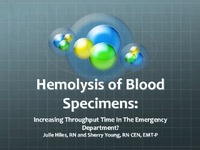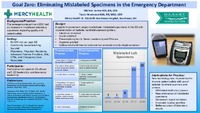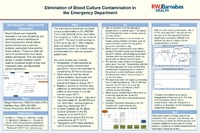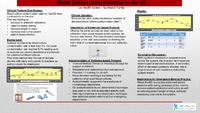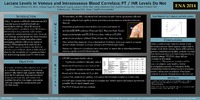| dc.contributor.author | Young, Sherry | en |
| dc.contributor.author | Hiles, Julie | en |
| dc.date.accessioned | 2011-10-27T10:28:28Z | |
| dc.date.available | 2011-10-27T10:28:28Z | |
| dc.date.issued | 2011-10-17 | en_GB |
| dc.identifier.uri | http://hdl.handle.net/10755/162452 | |
| dc.description.abstract | [ENA Leadership Conference] Evidence-based Practice Presentation: Hemolysis of Blood Specimens: Increasing Time In The Emergency Department<br/><br/>Purpose: The nurses in a rural Emergency Department (ED) noted an increased incidence of hemolysis of blood specimens after adopting the practice of nurses obtaining blood specimens via a newly established intravenous site (IV), increasing throughput time in the ED. The purpose of this study was to determine if there was a significant difference in the proportion of hemolysis of blood specimens obtained from a newly inserted IV using a 20g Advant IV safety catheter and blood specimens obtained from a 21g-23g straight needle venipuncture.<br/><br/>Design: Non-experimental descriptive quantitative retrospective design was selected to compare hemolysis of blood drawn via newly established IV site and the venipuncture site.<br/><br/>Setting: This study was conducted in a Level 2 ED of a 220-bed non-profit, community teaching Appalachian hospital. The ED volume was approximately 53,000 visits for fiscal year 2009.<br/><br/>Participants/Subjects: A convenience sample of 101 hemolyzed blood specimens drawn in the ED January, 2009- November, 2009 were included in this study, excluding specimens collected from minors, mastectomy, and dialysis patients.<br/><br/>Methods: IV site blood specimens were collected by randomly selected ED nurses with 2 or more years of ED experience, and the venipuncture specimens were collected by randomly selected ED technicians with 2 or more years of ED experience. Blood specimens were analyzed for hemolysis using a Hitachi automated spectrophotometer and visual inspection by the lab technologist. Hemolyzed specimens were stratified according to method of specimen retrieval: Group A = venipuncture and Group B= IV site. Using SPSS, Chi-Square was used to compare the groups.<br/><br/>Results/Outcomes: Of the 101 hemolyzed specimens, 65 (64.4%) were drawn by newly placed 20g IV catheter, while 36 (35.6%) were drawn by 21-23g venipuncture needle. There was a significant difference in the proportion of hemolysis in the two specimen collection methods, x2 (1, N= 101) =8.327; p<.01.<br/><br/>Implications: A decreased hemolysis rate would result in improved ED throughput, reduced length of stay for the patient, and improved patient satisfaction. Based on these results and review of evidence from other sources, a policy was developed describing the process for obtaining blood specimens for laboratory patient testing in the ED. All blood obtained for laboratory specimens will be drawn from peripheral site using straight needle venipuncture to decrease the rate of hemolysis. The rate of hemolysis will be monitored in the future to determine the effectiveness of this policy change.<br/></td></tr></table> | en_GB |
| dc.description.sponsorship | Emergency Nurses Association | en_GB |
| dc.language.iso | en | en |
| dc.title | Hemolysis of Blood Specimens: Increasing Time in the Emergency Department | en_GB |
| dc.type | Presentation | en_GB |
| dc.rights.holder | <p>
All rights reserved by the author(s) and/or publisher(s) listed in this item record unless relinquished in whole or part by a rights notation or a Creative Commons License present in this item record.
</p><p>
All permission requests should be directed accordingly and not to the Sigma Repository.
</p><p>
All submitting authors or publishers have affirmed that when using material in their work where they do not own copyright, they have obtained permission of the copyright holder prior to submission and the rights holder has been acknowledged as necessary.
</p> | |
| dc.description.note | Items submitted to a conference/event were evaluated/peer-reviewed at the time of abstract submission to the event. No other peer-review was provided prior to submission to the Henderson Repository, unless otherwise noted. | |
| dc.author.details | Julie Hiles, RN; Sherry Young RN, CEN, EMT-P, CICP | en |
| dc.date.conferenceyear | 2011 | en_US |
| dc.description.reviewtype | Abstract Review Only: Reviewed by Event Host | en |
| dc.description.acquisition | Proxy-submission | en |
